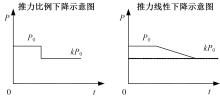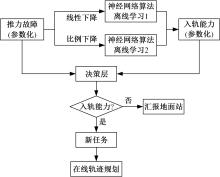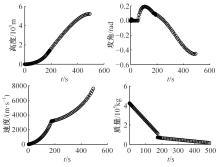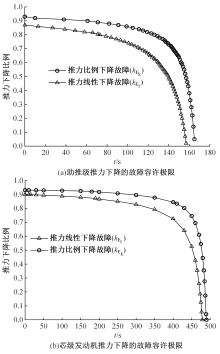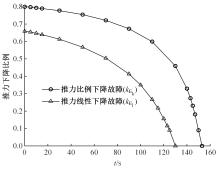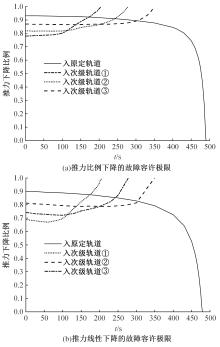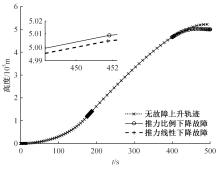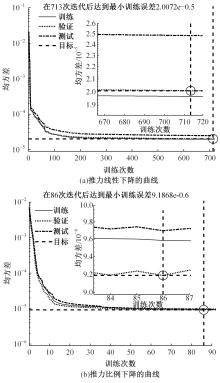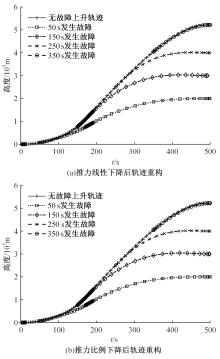吉林大学学报(工学版) ›› 2023, Vol. 53 ›› Issue (8): 2245-2253.doi: 10.13229/j.cnki.jdxbgxb.20211120
• 车辆工程·机械工程 • 上一篇
运载火箭推力下降时入轨能力评估与轨迹重构方法
- 1.南京航空航天大学 航天学院,南京 211106
2.北京航天自动控制研究所,北京 100854
Orbital capability evaluation and trajectory reconstruction for launch vehicle with thrust decline
Shuang LI1( ),Zi-rui LIN1,Song YE2,Xu LIU1,Ji-song ZHAO1
),Zi-rui LIN1,Song YE2,Xu LIU1,Ji-song ZHAO1
- 1.College of Astronautics,Nanjing University of Aeronautics and Astronautics,Nanjing 211106,China
2.Beijing Aerospace Automatic Control Institute,Beijing 100854,China
摘要:
为解决运载火箭推力下降时无法正常入轨的问题,基于局部配点法和神经网络提出了入轨能力评估与轨迹重构方法。首先,采用局部配点法求解燃耗最优入轨问题,离线生成不同推力下降故障时运载火箭进入目标轨道和次级轨道的轨迹数据库。然后,采用神经网络学习轨迹数据库,建立推力下降故障与入轨能力之间的映射关系,从而使运载火箭出现推力下降时能对入轨能力在线评估与决策。最后,采用局部配点法进行在线轨迹重构,实现运载火箭入轨。数值仿真结果表明,本文方法可实现运载火箭推力下降时入轨能力评估和在线轨迹重构,从而提高发射任务的成功率。
中图分类号:
- V488.23
| 1 | 李学锋. 运载火箭智慧控制系统技术研究[J]. 宇航总体技术, 2018, 2(2): 43-48. |
| Li Xue-feng. Research on GNC system of new generation intelligent launch vehicle[J]. Astronautical Systems Engineering Technology, 2018, 2(2): 43-48. | |
| 2 | 胡珊. 载人运载火箭主动段故障检测技术研究[D]. 西安: 西北工业大学航天学院, 2005. |
| Hu Shan. Research on fault detection of manned launch vehicle boosting stage[D]. Xi'an: School of Astronautics, Northwestern Polytechnical University, 2005. | |
| 3 | 黄盘兴. 重型运载火箭可重构控制系统设计研究[D]. 哈尔滨: 哈尔滨工业大学航天学院, 2012. |
| Huang Pan-xing. Research on reconfigurable control system design of heavy launch vehicle[D]. Harbin: School of Astronautics, Harbin Institute of Technology, 2012. | |
| 4 | Arther E, Bryson J, Ho Y C. Applied Optimal Control[M]. London: Blaisdell Publishing Company, 1969. |
| 5 | Dukeman G. Atmospheric ascent guidance for rocket-powered launch vehicles[C]∥AIAA Guidance, Navigation, and Control Conference and Exhibit, Monterey, California, USA, 2002: 1-11. |
| 6 | Lu P, Sun H, Tsai B. Closed-loop endoatmospheric ascent guidance[J]. Journal of Guidance, Control, and Dynamics, 2003, 26(2): 283-294. |
| 7 | Lu P, Griffin B J, Dukeman G A, et al. Rapid optimal multi-burn ascent planning and guidance[J]. Journal of Guidance, Control, and Dynamics, 2008, 31(6): 1656-1664. |
| 8 | Murillo O, Lu P. Fast ascent trajectory optimization for hypersonic air-breathing vehicles[C]∥AIAA Guidance, Navigation, and Control Conference, Toronto, Ontario, Canada, 2010: 1-24. |
| 9 | 韩雪颖, 马英, 程兴, 等. 运载火箭推力故障下的弹道重构策略研究[J]. 导弹与航天运载技术, 2019 (2): 7-11. |
| Han Xue-ying, Ma Ying, Cheng Xing, et al. Trajectory reconfiguration strategy research on launch vehicle with thrust failure[J]. Missiles and Apace Vehicles, 2019(2): 7-11. | |
| 10 | 湛康意, 陈海朋, 贺从园, 等. 基于间接法在线能力评估和自主规划技术研究[J]. 中国空间科学技术, 2021, 41(3): 31-38. |
| Zhan Kang-yi, Chen Hai-peng, He Cong-yuan, et al. Research on online capability assessment and autonomous planning technology based on indirect method[J]. Chinese Space Science and Technology, 2021, 41(3): 31-38. | |
| 11 | Darby C L, Hager W W, Rao A V. Direct trajectory optimization using a variable low-order adaptive pseudospectral method[J]. Journal of Spacecraft and Rockets, 2011, 48(3): 433-445. |
| 12 | Betts J T, Huffiman W P. Mesh refinement in direct transcription methods for optimal control[J]. Optimal Control Applications and Methods, 1998, 19(1): 1-21. |
| 13 | Jain S, Tsiotras P. Multiresolution-based direct trajectory optimization[C]∥The 46th IEEE Conference on Decision and Control, Piscataway, New Jersey, USA, 2007: 5991-5996. |
| 14 | Zhao J S, Li S. Modified multiresolution technique for mesh refinement in numerical optimal control[J]. Journal of Guidance Control and Dynamics, 2017, 40(12): 3328-3338. |
| 15 | Liu F, Hager W W, Rao A V. Adaptive mesh refinement method for optimal control using nonsmoothness detection and mesh size reduction[J]. Journal of the Franklin Institute, 2015, 352(10): 4081-4106. |
| 16 | Zhao J S, Li S. Adaptive mesh refinement method for solving optimal control problems using interpolation error analysis and improved data compression[J]. Journal of the Franklin Institute, 2020, 357(3): 1603-1627. |
| 17 | 宋征宇, 王聪, 巩庆海. 运载火箭上升段推力下降故障的自主轨迹规划方法[J]. 中国科学: 信息科学, 2019, 49(11): 1472-1487. |
| Song Zheng-yu, Wang Cong, Gong Qing-hai. Autonomous trajectory planning for launch vehicle under thrust drop failure[J]. Scientia Sinica Informationis, 2019, 49(11): 1472-1487. | |
| 18 | 周鼎, 梁艳迁, 梁建国, 等. 运载火箭任务降级轨迹规划问题特性分析研究[J]. 上海航天, 2020, 37(): 53-58, 70. |
| Zhou Ding, Liang Yan-qian, Liang Jian-guo, et al. Characteristic analysis of trajectory planning problem of orbit descent for launch vehicles[J]. Aerospace Shanghai, 2020, 37(Sup.2): 53-58, 70. | |
| 19 | 杨卓乔, 吕春红. 考虑时间约束的多飞行器轨迹优化方法研究[J]. 航天控制, 2021, 39(2): 11-16. |
| Yang Zhuo-qiao, Lv Chun-hong. Exploiting sparsity in local collocation methods for solving trajectory optimization problems[J]. Aerospace Control, 2021, 39(2): 11-16. | |
| 20 | 刘云昭. 基于神经网络预测的主动段轨迹在线生成方法研究[D]. 西安: 西安电子科技大学空间科学与技术学院, 2020. |
| Liu Yun-zhao. Research on the method of online trajectory generation for powered phase based on neural network prediction[D]. Xi'an: School of Aerospace Science and Technology, Xidian University, 2020. | |
| 21 | 赵吉松. 求解轨迹优化问题的局部配点法的稀疏性研究[J]. 宇航学报, 2017, 38(12): 49-58. |
| Zhao Ji-song. Exploiting sparsity in local collocation methods for solving trajectory optimization problems[J]. Journal of Astronautics, 2017, 38(12): 49-58. | |
| 22 | 赵吉松, 谷良贤, 佘文学. 配点法和网格细化技术用于非光滑轨迹优化[J]. 宇航学报, 2013, 34(11): 1442-1450. |
| Zhao Ji-song, Gu Liang-xian, She Wen-xue. Application of local collocation method and mesh refinement to nonsmooth trajectory optimization[J]. Journal of Astronautics, 2013, 34(11): 1442-1450. |
| [1] | 吕锋,李念,冯壮壮,张杨航. 面向用户的个性化产品服务系统协同过滤推介方法[J]. 吉林大学学报(工学版), 2023, 53(7): 1935-1942. |
| [2] | 刘鹏举. 基于深度神经网络的物联网安全态势自动辨识算法设计[J]. 吉林大学学报(工学版), 2023, 53(7): 2121-2126. |
| [3] | 刘培勇,董洁,谢罗峰,朱杨洋,殷国富. 基于多支路卷积神经网络的磁瓦表面缺陷检测算法[J]. 吉林大学学报(工学版), 2023, 53(5): 1449-1457. |
| [4] | 张振海,季坤,党建武. 基于桥梁裂缝识别模型的桥梁裂缝病害识别方法[J]. 吉林大学学报(工学版), 2023, 53(5): 1418-1426. |
| [5] | 冀汶莉,田忠,柴敬,张丁丁,王斌. 多属性融合分布式光纤导水裂隙带高度预测方法[J]. 吉林大学学报(工学版), 2023, 53(4): 1200-1210. |
| [6] | 田彦涛,许富强,王凯歌,郝子绪. 考虑周车信息的自车期望轨迹预测[J]. 吉林大学学报(工学版), 2023, 53(3): 674-681. |
| [7] | 于雅静,郭健,王荣浩,秦伟,宋明武,向峥嵘. 基于状态观测器的多四旋翼无人机时变编队控制[J]. 吉林大学学报(工学版), 2023, 53(3): 871-882. |
| [8] | 张帅帅,尹燕芳,肖林京,姜帅. 基于门控循环神经网络的四足机器人静步态规划方法[J]. 吉林大学学报(工学版), 2023, 53(3): 902-912. |
| [9] | 姚荣涵,徐文韬,郭伟伟. 基于因子长短期记忆的驾驶人接管行为及意图识别[J]. 吉林大学学报(工学版), 2023, 53(3): 758-771. |
| [10] | 刘近贞,高国辉,熊慧. 用于脑组织分割的多尺度注意网络[J]. 吉林大学学报(工学版), 2023, 53(2): 576-583. |
| [11] | 张惠臻,高正凯,李建强,王晨曦,潘玉彪,王成,王靖. 基于循环神经网络的城市轨道交通短时客流预测[J]. 吉林大学学报(工学版), 2023, 53(2): 430-438. |
| [12] | 马彦,郭则宣. 基于改进BPNN⁃MPF算法的锂离子电池SoE估计[J]. 吉林大学学报(工学版), 2023, 53(1): 263-272. |
| [13] | 朱冰,李紫薇,李奇. 基于改进SegNet的遥感图像建筑物分割方法[J]. 吉林大学学报(工学版), 2023, 53(1): 248-254. |
| [14] | 卢辉遒,赵枫,谢波,田彦涛. 冰雪环境下基于神经网络的驾驶人换道意图识别[J]. 吉林大学学报(工学版), 2023, 53(1): 273-284. |
| [15] | 李永明,裴小轩,伊曙东. 混合动力汽车动力电池自适应神经网络优化控制[J]. 吉林大学学报(工学版), 2022, 52(9): 2063-2068. |
|
||
